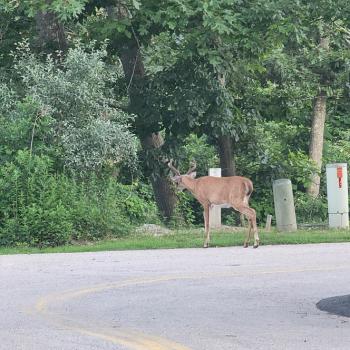Somewhere I heard or read that one of the top television programs in Finland (or Sweden or Norway) is a few hours of watching a fire burn in a fireplace. I don’t know whether or not this is true—I would hope that my Scandinavian cousins might go for a real fire in a fireplace rather than one on a screen. But Google “fireplace youtube video” and you will find several dozen to choose from.
During the two-hour final exam in one of my classes a couple of years ago, I put a fireplace video on the big screen up front while the students worked on their exams. Nobody commented on what I thought was a stroke of genius. I didn’t notice a significant increase in the quality of the exams, but I’d like to believe that it might have reduced the stress a bit. There is something mesmerizing and comforting about such videos; the one I chose is complete with the crackling of the logs (and no elevator music in the background). It’s low maintenance, too. No heat, but no kindling, no mess to clean up, no chance of the fire jumping out of the fireplace and causing damage, and no burns. There’s a lot to be said for domesticated fire—except that it isn’t fire. That’s what usually happens when we try to domesticate something wild and dangerous. It becomes something else entirely.
Domesticating the wild and dangerous is a favorite and necessary human activity, beginning with the domestication of the small human barbarians we call “children.” As a child, my favorite character in the pantheon of classic Bugs Bunny characters was the Tasmanian Devil. I lived vicariously through his uncontrolled and destructive energy. Who doesn’t occasionally wish for the opportunity to make a god-awful mess with impunity and without repercussions, just because you can? Mom doesn’t like the way I picked up my room? I’ll show you “picked up”! I whirl into a tornado of destructive frenzy, clothes and bedding flying everywhere, leaving a child-sized hole in the wall as I exit the scene. Dad doesn’t like my attitude? I’ll show you an attitude, as I leave flying paper and debris in the wake of my Tasmanian exit through your floor-to-ceiling bookcases. Just as the Tasmanian Devil was an infrequent visitor to the Bugs Bunny Show (maybe once every third Saturday),
I lived vicariously through his uncontrolled and destructive energy. Who doesn’t occasionally wish for the opportunity to make a god-awful mess with impunity and without repercussions, just because you can? Mom doesn’t like the way I picked up my room? I’ll show you “picked up”! I whirl into a tornado of destructive frenzy, clothes and bedding flying everywhere, leaving a child-sized hole in the wall as I exit the scene. Dad doesn’t like my attitude? I’ll show you an attitude, as I leave flying paper and debris in the wake of my Tasmanian exit through your floor-to-ceiling bookcases. Just as the Tasmanian Devil was an infrequent visitor to the Bugs Bunny Show (maybe once every third Saturday),  so I wasn’t looking to be destructive on a regular basis. Infrequent and arbitrary scenes of total chaos would have been enough to keep everyone on edge and suitably respectful.
so I wasn’t looking to be destructive on a regular basis. Infrequent and arbitrary scenes of total chaos would have been enough to keep everyone on edge and suitably respectful.
I thought of the Tasmanian devil not long ago when Psalm 29 was one of my morning psalms:
The voice of the LORD is over the waters; the God of glory thunders, the LORD, over mighty waters.
The voice of the LORD is powerful; the voice of the LORD is full of majesty.
The voice of the LORD breaks the cedars; the LORD breaks the cedars of Lebanon.
The voice of the LORD flashes forth flames of fire.
The voice of the LORD shakes the wilderness; the LORD shakes the wilderness of Kadesh.
The voice of the LORD causes the oaks to whirl, and strips the forest bare . . .
 Broken cedars, whirling oaks, naked forests—sounds like the Tasmanian devil has been here. But for the most part, this is not the God we encounter in church (or anywhere else for that matter). As Annie Dillard writes, we tend to “come at God with an unwarranted air of professionalism, with authority and pomp, as though [we] knew what [we] were doing, as though people in themselves were an appropriate set of creatures to have dealings with God.” We want contact with the divine, but not with the Tasmanian Devil deity or with the
Broken cedars, whirling oaks, naked forests—sounds like the Tasmanian devil has been here. But for the most part, this is not the God we encounter in church (or anywhere else for that matter). As Annie Dillard writes, we tend to “come at God with an unwarranted air of professionalism, with authority and pomp, as though [we] knew what [we] were doing, as though people in themselves were an appropriate set of creatures to have dealings with God.” We want contact with the divine, but not with the Tasmanian Devil deity or with the  God that Deuteronomy and Hebrews describe as “a consuming fire.” We want a domesticated God that we can predict and perhaps control. Why is that?
God that Deuteronomy and Hebrews describe as “a consuming fire.” We want a domesticated God that we can predict and perhaps control. Why is that?
In When God is Silent, Barbara Brown Taylor suggests that we opt for a domesticated God because we suspect that the alternative is too disturbing to consider. Religious history is littered with stories of those who asked to meet God face to face and barely survived to tell about it. “Many pray for an encounter with the living God. Those whose prayers are answered rarely ask for the same thing twice.” Persons of faith complain (frequently, endlessly) that God is silent, that no direct communication from the divine is ever forthcoming, at least not in a language anyone can understand. Just ask Job. But it just might be that God is silent because this is what, in our heart of hearts, we have asked for. As the children of Israel quaking in their boots at Mount Sinai after God’s direct communication, we would rather dabble around the edges, and we would much rather hire someone to represent God to us (and us to God) than take the face to face risk.
 We are not up to direct encounter with God. We want it but we don’t want it. We want to be warmed, not burned, except where God is concerned there is no such thing as a safe fire. Safe fire is our own invention. It is what we preach to people who, like us, would rather be bored than scared.
We are not up to direct encounter with God. We want it but we don’t want it. We want to be warmed, not burned, except where God is concerned there is no such thing as a safe fire. Safe fire is our own invention. It is what we preach to people who, like us, would rather be bored than scared.
The next time I am in church I’ll have a hard time forgetting the YouTube video of a fireplace burning. A pleasant enough experience, I suppose, but offering nothing of the warmth and danger of the original. As we proceed through the various portions of the liturgy—Gloria, Sanctus, sermon, creed, confession, collection, Sanctus, Agnus Dei and so on—Annie Dillard will be poking me in the side.
I often think of set pieces of liturgy as certain words that people have successfully addressed to God without their getting killed . . . If God were to blast such a service to bits, the congregation would be, I believe, genuinely shocked.
Indeed we would be—and attendance the following Sunday would be affected. Much better to pretend that we know what we are doing and that God somehow is entertained. Because the alternative—that God might actually show up and do something, including making us responsible for what we so blithely parrot every week—makes us uncomfortable. And above all else, human beings want to be comfortable.
 Why do we people in churches seem like cheerful, brainless tourists on a packaged tour of the Absolute? . . . On the whole, I do not find Christians, outside of the catacombs, sufficiently sensible of conditions. Does anyone have the foggiest idea what sort of power we so blithely invoke? Or, as I suspect, does no one believe a word of it? The churches are children playing on the floor with their chemistry sets, mixing up a batch of TNT to kill a Sunday morning. It is madness to wear ladies’ straw hats and velvet hats to church; we should all be wearing crash helmets. Ushers should issue life preservers and signal flares; they should lash us to our pews. For the sleeping god may wake someday and take offense, or the waking god may draw us out to where we can never return. Annie Dillard
Why do we people in churches seem like cheerful, brainless tourists on a packaged tour of the Absolute? . . . On the whole, I do not find Christians, outside of the catacombs, sufficiently sensible of conditions. Does anyone have the foggiest idea what sort of power we so blithely invoke? Or, as I suspect, does no one believe a word of it? The churches are children playing on the floor with their chemistry sets, mixing up a batch of TNT to kill a Sunday morning. It is madness to wear ladies’ straw hats and velvet hats to church; we should all be wearing crash helmets. Ushers should issue life preservers and signal flares; they should lash us to our pews. For the sleeping god may wake someday and take offense, or the waking god may draw us out to where we can never return. Annie Dillard












